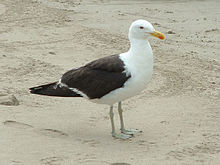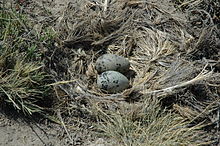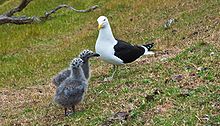- Kelp Gull
-
Kelp Gull 
In central Chile Conservation status Scientific classification Kingdom: Animalia Phylum: Chordata Class: Aves Order: Charadriiformes Family: Laridae Genus: Larus Species: L. dominicanus Binomial name Larus dominicanus
(Lichtenstein, 1823)The Kelp Gull (Larus dominicanus), also known as the Dominican Gull, breeds on coasts and islands through much of the southern hemisphere. The race L. d. vetula occurs around southern Africa, and nominate L. d. dominicanus is the subspecies found around South America, parts of Australia (where it overlaps with Pacific Gull), and New Zealand (where it is known as the Southern Black-backed Gull or by its Māori name Karoro). The specific name comes from the Dominican order of friars who wore black and white habits.[1] It is the southern equivalent of the northern hemisphere's Lesser Black-backed Gull, but averages slightly larger than that species at 54–65 cm in total length and 128–142 cm in wingspan. This is a mainly coastal gull.
The nest is a shallow depression on the ground lined with vegetation and feathers. The female usually lays 2 or 3 eggs. Both parents feed the young birds.
Contents
Description
The adult Kelp Gull has black upperparts and wings. The head, underparts, tail and the small "mirrors" at the wing tips are white. The bill is yellow with a red spot, and the legs are greenish-yellow (brighter and yellower when breeding, duller and greener when not breeding). The call is a strident ki-och. Juveniles have dull legs, a black bill, a dark band in the tail, and an overall grey-brown plumage densely edged whitish, but they rapidly get a pale base to the bill and largely white head and underparts. They take three or four years to reach maturity.
The African subspecies L. d. vetula is sometimes split as the Cape Gull, L. vetula. It has a more angular head and a smaller shorter bill. The adult has a dark eye, whereas the nominate Kelp Gull usually has a pale eye. Young Cape Gulls have almost identical plumage to similarly aged Kelp Gulls.
Behaviour
Kelp Gulls are omnivores like most Larus gulls, and they will scavenge as well as seeking suitable small prey. It gathers on landfills and a sharp increase in its population is therefore considered as an indicator for a degraded environment.[2] Kelp Gulls have been observed feeding on live right whales since at least 1996.[3] The Kelp Gull uses its powerful beak to peck down centimetres into the skin and blubber, often leaving the whales with large open sores, some of which have been observed to be half a meter in diameter. This predatory behavior has been continually documented in Argentinian waters, and continues today.[4]
Various views and plumages
-
Cape Gull (L. d. vetula), Boulders Beach, South Africa
-
Larus dominicanus, photograph taken at Concón, Chile
-
Kelp Gull (subspecies L. d. dominicanus) stealing a meal of shellfish from Blackish Oystercatchers in Bahía Inglesa, Chile
See also
References
- ^ "Shelly Farr Biswell", "Southern Black-Backed Gulls", New Zealand Geographic, number 73, May–June 2005
- ^ Cf. José Felipe M. Pereira, Aves e Pássaros Comuns do Rio de Janeiro, Rio de Janeiro: Technical Books, ISBN 978-85-61368-00-5, pg.55
- ^ Increased harassment of Right Whales (Eubalaena australis) by Kelp Gulls (Larus dominicanus) at Península Valdés, Argentina. Rowntree, V.J., P. MacGuiness, K. Marshall, R. Payne, J. Seger, and M. Sironi, 1998. Marine Mammal Science. 14(1): 99 - 115. doi:10.1111/j.1748-7692.1998.tb00693.x
- ^ Gulls' vicious attacks on whales. BBC News, June 24, 2009.
- BirdLife International (2004). Larus dominicanus. 2006. IUCN Red List of Threatened Species. IUCN 2006. www.iucnredlist.org. Retrieved on 11 May 2006. Database entry includes justification for why this species is of least concern
- Ian Sinclair, Phil Hockey and Warwick Tarboton, SASOL Birds of Southern Africa (Struik 2002) ISBN 1-86872-721-1
- Seabirds by Harrison, ISBN 0-7470-1410-8
External links
- Kelp Gull pictures on jostimages.com
- Specimens of Larus dominicanus in the collection of Museum of New Zealand Te Papa Tongarewa
Gulls (family: Laridae) Genus Larus Pacific Gull • Belcher's Gull • Olrog's Gull • Black-tailed Gull • Heermann's Gull • Common Gull (or Mew Gull) • Ring-billed Gull • California Gull • Great Black-backed Gull • Kelp Gull (or Cape Gull) • Glaucous-winged Gull • Western Gull • Yellow-footed Gull • Glaucous Gull • Iceland Gull • Kumlien's Gull • Thayer's Gull • European Herring Gull • Heuglin's Gull • American Herring Gull • Yellow-legged Gull • Caspian Gull • Vega Gull (or East Siberian Gull / Mongolian Gull) • Armenian Gull • Slaty-backed Gull • Lesser Black-backed GullIchthyaetus Leucophaeus Chroicocephalus Saundersilarus Hydrocoloeus Rhodostethia Rissa Pagophila Xema Creagrus Categories:- IUCN Red List least concern species
- Gulls
- Larus
- Birds of New Zealand
- Birds of South Africa
- Birds of South Australia
- Birds of Tasmania
- Birds of Western Australia
- Birds of South Georgia and the South Sandwich Islands
- Fauna of the Kerguelen Islands
- Animals described in 1823
- Fauna of the Prince Edward Islands
- Fauna of Macquarie Island
- Fauna of Campbell Island, New Zealand
- Fauna of Heard Island and McDonald Islands
-
Wikimedia Foundation. 2010.








